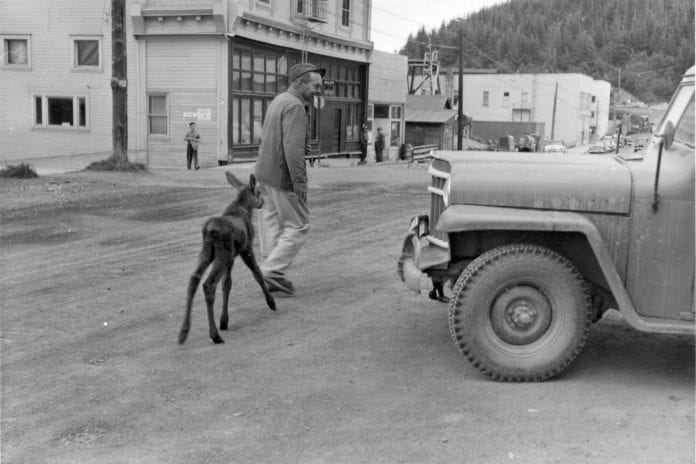
Most everyone knows the huge ungulates were transplanted here, but the details are worth revisiting. We all owe a big debt of gratitude to those ambitious go-getters of the late 1940’s and early ‘50s who spearheaded the effort.
It started with the local Isaac Walton League, who at that time held their meeting in a cabin in Nirvana Park. Hollis Henrich, Ross Green, Ed King, Don Green, Curly Hoover, and Charley Evans lead the effort. Alaska was a territory back then, and it required the approval of local Fish and Wildlife agent Fred Robards, plus Holder Larsen in Anchorage.
Clarence Rhodes, top agent for the USFWS in Alaska, thought it was a wonderful idea. Plus Andy Simons, well known authority on game in Alaska and head of the territorial big game guides, also gave his approval.
Approval by all the agents lead to the first transplant of abandoned calves from the Kenai Peninsula via Mudhole Smith’s Cordova Air Service in 1949.
A young bull and two cows where flown in, to be raised in the lawn in the front of the old Post Office, now the USFS Building, mainly by Henrichs, the Postmaster; and Ross Green, the Post Office Caretaker.
Once strong enough, the young moose were released into a block-size penned area where Mt. Eccles Elementary now stands.
Successfully nursing the young calves proved a challenge, and only the one bull survived the first year. He was naturally named Kenai, and was released that fall at the junction of the highway and the Sheridan Glacier Road. Can you imagine being the only little moose wandering around the Delta that winter and following spring?
He proved to have the right stuff, and according to Ed King, “no doubt sired the first moose to be born on the Delta.” Which didn’t take long. Robards reported observing a cow with calf in the fall of 1952, which meant the cow has bred as a yearling and bore a calf as a two year old. Go Kenai!
The Isaac Walton League became much better at rearing the young moose, and the program continued until 1958, with a total of 24 calf moose being transplanted.
Amazingly, by 1960 the herd had grown big enough to allow the first hunt. Twenty five bulls, by permit only, were taken that year.
The next harvest was held in 1962, again 25 bulls, this time an open hunt instead of by permit drawing. Over the years, the herd grew and expanded to the east side of the Copper River, with increasing harvest of both cows and bulls. The first antlerless hunt was held in 1968.
Hunters became more efficient, particularly with the use of airboats, in harvesting moose far off the road. In 1978, during an open hunt on both sides of the river for a total of 80 moose, 120 were taken in the first day, before ADF&G could shut it down.
What would you guess is the total number of moose that have been taken from that first hunt in 1960 through 2011? The answer is 5040 moose.
Using the conservative estimate of 500 pounds of meat, cut and wrapped, per animal, that is an astonishing 2,520,000 pounds. Roughly 1000 pounds of moose per Cordovan.
Editor’s Note: This article is a re-print that originally ran in the Sept. 21, 2012 edition of The Cordova Times.














